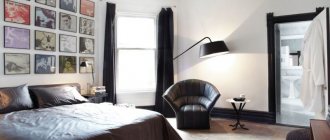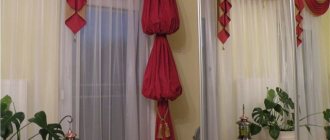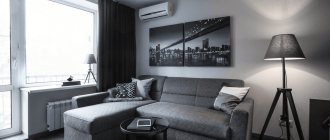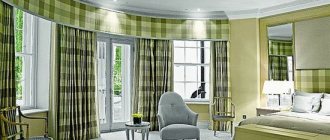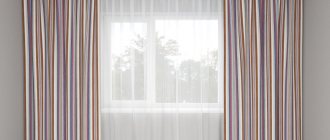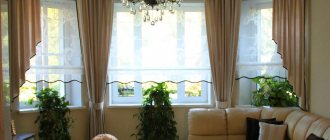Selection by type
Photo: Shutterstock
There are four main types of tulle fabrics: voile, organza, gauze and mesh. Each type has its own advantages and disadvantages that are worth knowing about.
Veil
lighter than other types and gathers into soft folds. It also does not diffuse light and does not allow air to pass through well, which makes it a suitable solution in a situation where there are no curtains and no curtains in sight. The veil also does not require special care. Its disadvantages are a continuation of its advantages - it “darkens” the room, which makes it not the best choice for dwellings on the lower floors with windows facing north. Well, in the summer it simply “chokes” rooms without air conditioning.
Organza
holds its shape well, transmits light, does not wrinkle or accumulate dust, and is easily washable in a washing machine. Organza, by the way, is not a type of fabric, but a method of weaving it, so organza can even be made of polyester, which significantly reduces the cost of the final product. Organza also comes with prints, flame retardant, “chameleon”, etc. And besides the high price, it has only one disadvantage: the inability to let air through.
Photo: PantherMedia/Scanpix
Gas
on our shelves it is almost entirely synthetic, which many are unaware of. Gauze fabrics have long been loved for the durability of the silk from which they were woven, but 90% of gauze tulle silk was seen only in pictures. Of course, gauze tulle is also made from silk - but for some money you won’t like them either.
Gas tulle is divided into different types, from gas-rice to gas-illusion, and they all differ in some way. The latter, for example, is made of ultra-thin threads and therefore allows light, air and everything in the world to pass through. Synthetic gas is probably the cheapest type of tulle, while outwardly it differs little from its counterparts, which is why we love it among people on a budget.
Net
- this is the “largest” tulle, which is almost never used separately, only together with curtains and curtains. Excellent transmission of light and even very small flies. There are several types of mesh tulle, from the popular muslin made of heavy-duty nylon (ideal for children) to French mesh with unusual openwork and very beautiful patterns. The only serious drawback of the mesh - besides the fact that it is extremely rarely used as a separate decorative element - is its ability to collect dust. People with dust allergies should avoid this type of tulle like the plague.
27.10.2015 04:00
The materials used for sewing curtains are divided into curtains and tulle. Fabrics of the first type are distinguished by a dense texture and heavy weight - drapery curtains are very heavy and voluminous, they are great for rich, luxurious interiors in a classic or oriental style, but are completely inappropriate in a lighter environment.
When it is necessary to decorate a window with a light, airy composition, tulle fabrics are used. Unlike curtain materials, they allow air and light to pass through well, have a very low density and, accordingly, weight.
The main material for making tulle fabrics is polyester. Depending on what additives and combinations of polyester are used with other materials of artificial and natural origin, the following types of tulle fabrics are distinguished:
- nylon;
- mesh;
- compressed;
- organza;
- veil;
- tulle fabric is a more modern material in the form of a transparent fabric on which a pattern of rubber threads is applied.
In addition, there are also classifications of tulle based on other characteristics. For example, there are single-sided fabrics and fabrics with a pattern applied on both sides of the fabric. Transparent tulles and matte varieties are also divided into separate categories.
Thus, veil and organza are two types of tulle, each of which has certain properties and characteristics. It is voile and organza that are most often used when creating modern apartment interiors, so it makes sense to talk about these fabrics in more detail.
Features of choice in different rooms
The choice of tulle depends on the purpose of the room, the degree of its illumination, the preferences and age of the residents.
Bedroom
For a bedroom with windows facing south, choose thick fabric in brown shades or with a printed pattern to muffle the sunlight.
For dark colors, colored organza without a pattern, transparent veil or chiffon are suitable. They not only transmit light well, but also visually increase the volume of the room.
Hall
The tulle for the hall should be in maximum harmony with all objects and create a comfortable atmosphere in combination with curtains. Curtains can become a style-forming object, a bright, extraordinary accent or an inconspicuous background for the decor of the room.
Children's
Tulle for a nursery is chosen based on the principles of environmental friendliness, safety, and compliance with the style of the room. With the help of curtains they create an atmosphere of fabulousness and creativity.
For boys, blue, yellow, and brown tulle tones with marine or space-themed designs are suitable; for girls, more delicate white and pink shades with various decorations and accessories are suitable.
For a teenager
For older boys, it is worth using high-tech tulle in light gray tones with metallic threads. They go well with blinds located vertically or horizontally.
Organza - basic properties, pros and cons.
Organza is a thin, light and very transparent fabric. From a technological point of view, it is a combination of natural silk material with the addition of synthetic fibers. Most often, the same polyester is used as an additive, but sometimes it is replaced with viscose.
The technology for making organza is very complex and labor-intensive; the material goes through several phases of very specific processing. This explains the high cost of such fabrics, but in fairness it should be noted that the price of organza is fully justified by its quality and remarkable decorative properties.
For example, despite its external lightness, organza is characterized by high strength and elasticity. Such curtains are very wear-resistant and, with proper handling and proper care, can last for many years.
Modern industry produces a large number of varieties of organza. It can be plain or patterned, matte or shiny, crinkled, perforated, sprayed, etc. Not so long ago, chameleon organza appeared - the fabric can change its color when the lighting or viewing angle changes.
Professional designers consider the advantages of organza to be transparent and airy, as well as good compatibility with most curtain fabrics. Organza does not require special care, it does not attract dust, and can be easily washed if necessary. When exposed to direct sunlight for a long time, this material does not fade, maintaining its original appearance.
However, organza cannot be called an ideal material for curtains, as it has disadvantages. The main disadvantage is that puffs and other minor defects that may form on the surface of the fabric cannot be repaired. Therefore, it is not recommended to use organza in homes with active pets.
Non-standard windows
If you need to emphasize the original or unusual shape of the window, then in this case you can also safely use tulle.
With balcony door
The design of the curtains should match the doors and not interfere with their functioning.
The photo shows a room with a balcony door decorated with tulle.
Arch
This form of window opening is itself a decorative element; to enhance this effect, it is worth using tulle compositions for decoration. It is not recommended to use massive structures.
Bay window
When choosing curtains for a bay window, it is better to use not very dense fabric in pastel shades to add spatial depth to the room.
The photo shows a classic-style hall with a bay window and light curtains.
Corner window
In order to give such windows a special sophistication and emphasize grace, you can choose a translucent, weightless fabric in light colors.
For two windows
Two window openings with a partition or a room where the living room is combined with a kitchen can also be decorated with tulle, in which case unnecessary workload can be avoided.
Let's get acquainted with the veil.
Voile is a translucent fabric with a matte surface and smooth texture. Thanks to its denser structure, the veil, unlike transparent organza, is well suited for hiding certain repair defects, defects in walls or window openings, as well as the landscape outside the window that is not very pleasant to the eye.
Designers often use a veil in cases where a room needs to be slightly darkened. This is true for rooms whose windows face the sunny side. This is another significant difference between a veil and organza, which practically does not block light from the street and therefore can only be used in combination with thicker drapery curtains
.
If we talk about the rigidity of tulle fabrics, then the veil is a softer material than organza. It lends itself well to processing, and it is easy to form the desired compositions from it by draping curtains.
One of the disadvantages of the veil is its high ability to become electrified. Due to this, curtains made of this material attract dust and become dirty very quickly. At the same time, removing a stain placed on a veil is not an easy task, so it is better not to hang such curtains in the kitchen.
In addition, the veil fades very quickly when exposed to direct sunlight. As a result, the decorative properties noticeably deteriorate, the surface loses its shine, the design fades and merges with the main background.
So, let's summarize. Tulle, veil, organza - all these are materials with similar properties from the same group of tulle fabrics. Their main feature is transparency and lightness. But if organza is absolutely transparent and completely transmits light from the street, then the veil partially blocks the sun's rays, which allows it to be used to darken a room.
There are also differences in terms of texture. Organza is a more rigid and durable material, while voile is a soft fabric, making it much easier to work with and solve complex window decorating tasks.
In the interior of a home, a special place is given to curtains. Together with curtains, they not only create a barrier to excess daylight and prying eyes, but also decorate the room, making it stylish and cozy. The most common material for curtains is tulle, which comes in many varieties. Among them are transparent fabrics such as organza, veil, mesh and many others. In order to correctly choose the most suitable material for your curtains, you need to know how each of them differs from the other.
Characteristics of tulle types
Transparent and lightweight tulle fabric takes its name from the city of the same name, located in southwest France. It became widespread in the 19th century, when thin, openwork fabric began to be used to decorate living spaces. Soon, hand-made production was replaced by special machines, which made it possible to reduce the price of tulle.
Today, various types of tulle are produced -. A wide selection and rich assortment can completely change the atmosphere, create comfort, combining the play of light and shadow. How to choose tulle and take into account the lighting features of the room and the size of the window opening? For window decoration, thin tulle is used, which creates a harmonious combination with thick curtains. Individual finishing is often carried out using tulle with photo printing: such products are sewn according to an individual sketch, which is transferred to the fabric in two ways:
- using thermal paper, on which the sketch is pre-printed and then transferred to the canvas;
- For synthetic fabrics, sublimation transfer is used.
You may also be interested in: Design and photo of linen tulle, care of tulle curtains
Patterned tulle adds individuality and lightness to the design of the room. The design often uses fabric with unevenly woven threads, called rain tulle. The rain effect is applied to a plain surface of fabrics such as organza, voile, crystalline, mesh.
Tulle on windows with a plain texture is used as a neutral background. There are the following types of material design:
- plain;
- rain carnival;
- rain is a rainbow in which the color transitions in a vertical direction.
Pleated tulle is a simple, affordable and effective solution for decorating windows of apartments, offices, attic and ceiling window openings. The tulle design combines the mesh texture of the fabric with a pattern made in the form of folds laid to one side. The main advantages of tulle are ease of care, practicality, and resistance to sunlight.
Thick tulle is a material with varying degrees of protection from light, since its light texture provides diffused exposure to sunlight. Patterned tulle, which has a number of varieties, is also used for sewing bedspreads and capes. Tulle curtains made from this type of fabric look great in small window openings.
Tulle arch emphasizes the originality of the interior - a short curtain with a beautiful arched bottom edge is a practical and stylish solution for room decor. Lace tulle is a decorative fabric with threads intertwined in the form of various patterns, which is used to decorate textile items. By skillfully combining translucent fabric with lace tulle, you can create curtains that will decorate the room.
Gossamer tulle is made from organza or a mixture of silk and synthetic threads. It combines lightness and elegance with high strength. The structure of the fabric is quite dense. In the interior it looks casual and cute.
Lace tulle allows both air and light into the room without any hindrance. A transparent curtain is ideal for the living room, which goes well with curtains made of thick, plain fabric. Weightless lace tulle in the bedroom interior is combined with linen curtains or curtains made of cotton fabric.
You may also be interested in: Selection of night curtains - fabrics and colors for curtains
Tulle mesh with rhinestones looks original and beautiful. It is a lightweight material with numerous cells and decorated with shiny rhinestones, which give it a certain shape without weighing it down. This material is used for curtaining window openings in hot weather. It looks great with curtains made of thick fabric. The window opening can be decorated with tulle with lace or a printed pattern.
When choosing fabric for decorating kitchen windows, you should consider the following:
- the canvas should filter light well;
- create a cozy environment;
- maintain privacy.
Lace tulle for the kitchen should correspond to the size of the window, and the length should be chosen at your discretion. It can be slightly higher than the bottom of the window opening, lower or as long as the floor.
Romance and aristocracy
Almost weightless ones are made from cotton or polyester, less often - from silk. The main differences between this mesh fabric and other materials in the “tulle” group are as follows:
- softness;
- moderate transparency;
- lightness and airiness;
- ability to drape;
- a variety of colors, including degrade.
A delicate and airy veil is ideal for an interior in a romantic style. It forms graceful “flowing” draperies and is ideal for lambrequins or creating a colored background in window openings. Using this material you can also create various combinations of colors and shades in one curtain. However, it is recommended to use such curtains only in rooms with a high level of natural light or, if necessary, to dim the bright rays of the sun.
Flaws:
- However, you need to remember that the veil is less durable, and stains on such a transparent fabric are difficult to wash off and are very visible in the light. In this regard, it is better not to use such curtains, even synthetic ones, for the kitchen or in a teenager’s room, but they will look great in the bedroom or living room.
- In addition, when stored folded, the veil can form creases that are difficult to remove, so it must be rolled up.
- It is recommended to wash by hand and without spinning, and iron only through a cloth.
Curtains and styles
If the decoration of the apartment is subject to any style, then in the answer to the question of how to choose curtains for the windows, there should be an indication of the need to adhere to the appropriate design.
After all, the classic style does not accept light, transparent curtains, and minimalism does not accept heavy brocade curtains with an abundance of expensive curtain decor.
High-tech will not accept curtains with floral motifs, and curtains of complex designs with draperies in several tiers will not suit a rustic setting.
Are you having difficulty choosing curtains for a room decorated in a stylistic direction such as Baroque?
Remember the general characteristics of this style. It will immediately become clear to you that window decoration should be as luxurious and expensive as possible.
Take a closer look at the curtains made of “status” fabrics of natural origin, decorated with ruffles, fringes, and tassels.
Curtains for the bedroom - 135 photos of the best new products and exclusive designs. Review of unusual design options and combinations of curtains in the bedroom interiorCurtains for suspended ceilings - features of design and selection of curtains for interiors (135 photos)
- How to decorate curtains - useful tips and options for the best decoration ideas on 115 new photos!
Modern design, on the contrary, loves conciseness, simplicity and restraint. Apart from strict monochrome paintings, nothing can appear here.
The most transparent curtains
Among all types of textiles, united by the name “tulle,” organza occupies a special place - a very transparent and rather rigid material. It is made from very thin twisted fibers of cotton, viscose, polyester, as a result of which the fabric acquires shine and elasticity. Its surface can be smooth, matte or crinkled, and the colors and translucent patterns can be very diverse. Organza with gold or silver plating, metal threads, as well as chameleon organza, the surface of which changes color depending on the viewing angle, and “rainbow” with iridescent shades, are very common.
Modern technologies make it possible to produce organza with trendy figured perforations, appliqués and other types of decoration. Organza curtains have the following advantages:
- transparency;
- beautiful and varied decor that can be used in interiors of any style and in any room;
- strength;
- the ability to form lush folds and gathers.
However, this material has rigidity, as a result of which creases can form on it. These curtains can be washed in an automatic delicate cycle. After drying well, they rarely need ironing. If necessary, this is done by heating the iron to a temperature corresponding to the composition of the fabric. To better smooth out creases, it is recommended to place a damp cloth on both the top and bottom of the curtain.
Main varieties
Thanks to the huge variety of tulle models for the windows of any room, you can find an interesting design solution. The options differ in many respects - pattern, texture, density.
With drawings
A decorative element in the form of a drawing or photo print on tulle curtains can decorate the interior of any room - kitchen, living room, children's room. It is important to choose decor that matches the style and purpose of the room. Such curtains can attract attention due to the brightness and beauty of the design.
Lace
Lace tulle helps create coziness and a comfortable atmosphere. Most often they are used in interiors created in the Provence or shabby art style. Lace looks especially impressive in the living room and kitchen.
Textured
Tulle with an unusual texture looks very expressive. The weave of threads of different colors and thicknesses gives the curtains a unique look. Knots, stripes, paths, made chaotically or in a certain order, are noticeable decorative elements of curtains.
Mesh
Mesh tulle has been very popular lately. Its sparse texture allows sunlight to pass through well. The appearance of a mesh curtain looks more advantageous if colored or shiny threads are woven into the fabric.
Kiseya
Thread curtains or muslin are a hit on the window textile market. They are a braid assembled from threads on which beads are strung. Kisey is used for decorating windows and zoning space.
Austrian
Tulle in the form of an Austrian curtain is a rectangular fabric that is assembled using cords threaded into sewn rings. It is lifted up, collected into beautiful folds. When sewing such curtains, you should carefully calculate the length so that when straightened, the tulle has scallops.
Roman
To make a Roman blind from tulle, you need to fold the top edge of the fabric, insert an insert there and attach it to the curtain rod. The lower one along its entire length is equipped with a weighting agent, which allows you to keep the curtain taut. After rising up, beautiful folds form on it.
Turkish
With the help of Turkish tulle it is easy to cover up the not-so-beautiful panorama opening from the window. Textiles can change the geometry of space and fill it with light.
Turkish tulle with a special texture, beautiful embroidery with gold threads, decorations and accessories that you want to look at.
Organza
A beautiful, transparent fabric for windows with a slight sheen, organza is durable and UV resistant. It does not wrinkle because it is made of silk combined with synthetic fibers. Organza tulle is decorated with embroidery or photo printing.
Veil
The fabric is light, soft, translucent. The veil has a matte, slightly rough surface. The mesh structure is formed using cotton, polyester or silk. The fabric drapes beautifully and effectively decorates the window. Often used in Provence or country style interiors.
See also
How to choose and sew curtain tape to tulle at home
Viscose
The material is very similar to silk, but its cost is lower. Using chemical processes, viscose is obtained from organic raw materials - spruce, fir, pine. The fabric is resistant to sunlight, but for greater effect, polyester threads are added to it. Viscose tulle is decorated with embroidery or printed patterns.
Chiffon
Chiffon tulle with a soft, transparent, matte structure. It consists of silk, cotton, polyester, nylon. Curtains are decorated with lace and printed patterns. The material is practical and easy to care for.
Fatin
Fabric made of nylon and polyester mesh structure. For tulle, tulle of medium hardness is used. Curtains can be transparent or translucent, with large or small mesh, shiny or matte. Most often, tulle is used without curtains, forming deep folds in the fabric.
Is there a compromise?
Both veil and organza have their own advantages and disadvantages, and their prices are almost comparable and are determined by their quality and type of finish. A micro-veil or semi-organza could be a compromise. This tulle combines the properties of both materials - softness and sophistication, transparency, plasticity, resistance to deformation and a variety of decor.
Tulle is a light translucent, smooth, mesh or patterned woven material made from natural cotton, linen, silk or mixed threads. This beautiful, elastic, durable, easy-to-care textile, thanks to its inexhaustible decorative possibilities, has not lost popularity for hundreds of years.
Types of tulle for the room
Tulle is selected to match the design of the room.
This is not difficult to do, since there are varieties of it, such as:
- Net. This is the most transparent of the types. But it is not always made of thin threads. Such a curtain does not protect from the sun, but it will become a stylish decorative element.
- Tulle with embroidery. You can often see him in photos in catalogs and glossy magazines. Both silk and metallized threads are used for embroidery. The patterns can be anything – classic monograms or flowers, or geometric prints. The choice depends on the design of the room.
- Thick tulle with horizontal or vertical stripes. They can be of any width, which allows you to achieve different effects - for example, visually expand the space or make the ceilings higher.
- Gossamer tulle. This is a fabric consisting of an interweaving of synthetic (less often silk) threads that resemble a spider's web. Despite the fact that such tulle looks weightless, it is considered quite durable.
- Kisey, or thread curtains. This tulle protects the room well from the sun and drapes easily. It is often used to decorate windows on the veranda or the entrance to the loggia. In addition, such curtains, often decorated with decor and beads, separate the hallway from other rooms.
There are other varieties that differ in style and manufacturing technique. For example, curtains with thermal printing are popular.
Who invented tulle
Hundreds of years have passed since tulle fabric first came off the loom. During this time, the history of its appearance has acquired many interesting, but not entirely plausible facts. It is believed that the order for its production came from Louis XI the Prudent himself back in the 15th century. The French king wanted the weavers to create a curtain behind which he could watch his courtiers, but they would not see him.
In fact, textiles of this type - light and transparent - were first produced in Great Britain at the end of the 18th century, and they were used not for sewing curtains, but for making clothes.
Thanks to its transparent airy texture, lightness and elegance, tulle at one time became the main competitor of lace fabric, differing from it only in manufacturing technology and structure, but not in appearance. Photos of unusually beautiful tulle lace can still be seen in old fashion catalogs. It began to be used as curtain fabric much later.
But the very meaning of the word tulle has French roots. This material received its name in honor of the small French weaving town of Tula with a population of just over 15,000 people. It was here that it began to be produced on an industrial scale. Then the name “Tulle”, almost unchanged, spread throughout the world.
The second name for tulle fabric is bobinette. It comes from a special structure, which is something between a woven and a woven fabric, since the longitudinal warp threads of classic tulle are not intertwined with each other, but are wrapped around threads wound on bobbins (bobbins).
Expensive types of tulle are still used today as inserts on wedding dresses, silk nightgowns, and luxury underwear. But out of ignorance, such decor is often mistaken for lace, guipure and tulle.
Choosing curtains with tulle
But the design of the window opening sometimes plays a decisive role in the decor of the room. Even perfectly combined colors of surfaces, pieces of furniture and decor that match in style, high-quality, beautiful textiles and soft upholstery will not “play out”, but will lose their attractiveness and charm if the window is incorrectly designed.
Tulle and curtains regulate the illumination of the interior space, and the light passing through the curtains creates a particular mood in the room. Not to mention the design, the method of draping and the presence of lambrequins: they are able to change the space, turning a nondescript small room into a bright hall, and a room of impressive size into a small, poorly lit closet.
What is tulle made from?
Several centuries have passed since the appearance of the first tulle fabrics. During this time, not only production technologies have changed, but also the material itself. Unlike lace, which was originally woven only by hand, bobbinette is made by machine from the very beginning.
If we talk about what exactly tulle is made from, then to produce durable and elastic tulle material, polyamide and polyester chemical fibers, as well as their mixed (cotton and silk) varieties, are mainly used. The raw materials for smooth fabric are high-twist cotton yarn, nylon and lavsan fiber, and if we talk about textiles with a pattern, bulky threads such as melan, belan, viscose.
How to do it?
In order to decorate the glass in this way, you will need tulle and glue. You can use old tulle as material or purchase scraps. The size of the pieces must correspond to the dimensions of the glass.
Regular starch should be used as glue; it should not be replaced with anything else. Starch perfectly adheres thin fabric, is easily washed off with water, and protects the tulle structure from dirt and dust.
The paste from it is prepared in the following proportions:
- one tablespoon of powder, maybe with a slide;
- half a liter of warm, but not hot water.
The mixture should be completely homogeneous, without lumps. You can mix the paste using a mixer, or you can do it manually.
You need to soak the tulle pieces in the resulting mixture and let them soak. After this, the tulle must be applied to the glass, pressed tightly and gently smoothed from the center in the directions down, up and to the sides. You can smooth it with your palms, or you can use a soft squeegee. To be safe, you can go over the tulle already placed on the glass with a brush dipped in starch paste.
Areas of application of tulle
Depending on the quality of the weaving, the saturation of the pattern or photo printing, as well as the density of the pattern, the tulle may be opaque. Curtains made from it are suitable for use not only during the day, but also at night.
Modern types of tulle are distinguished by:
- colors (white, colored and variegated);
- manufacturing method (presence or absence of a pattern).
Elastic, durable and dense tulle in white and all shades of the pastel palette is the most common. Recently, tulle with complex bright patterns and 3D photo printing has become popular.
Initially, tulle was only smooth, woven on tulle machines based on two thread systems. A little later, patterned tulle appeared, consisting of three systems of threads, and the patterns on it became more and more complex over time.
Today, smooth tulle fabric is used for sewing and finishing women's dresses, blouses, underwear, nets, embroidery and similar piece goods. Tulle with patterns is called curtain and is used as interior textiles. Plain and multi-colored curtains, bedspreads, tablecloths, capes, and decorative napkins are made from it.
The secret to the enduring popularity of tulle is that this material is universal. Depending on the manufacturing technology and composition, it can be either elite or affordable. At the same time, any of its varieties looks presentable and dignified. Perhaps this is why it has become an almost indispensable attribute of interior design and is present in one form or another, without exaggeration, in almost every home.
In the 15th century, the king issued a decree according to which weavers had to invent dense fabric to hide a person, but at the same time, so that the person being hidden could see everything that was happening in front of him. And this fabric was created in the city of Tulle, where it got its name. So what is tulle?
Drawings and patterns
A universal solution to any interior issue.
Stripes
A two-color stripe will increase the space of a small room, and depending on the color of the stripe, it can add playfulness or restraint to the interior. For a living room with low ceilings, you should not choose tulle with horizontal stripes.
Lace
Openwork lace in the room will give it a gentle romantic look, and also bring comfort and coziness.
Flowers
This floral arrangement creates a mood, gives energy and freshness to the room. Floral patterns with curls are often used in a room in Provence, country or rustic style.
With embroidery
Embroidery gives the curtains a rich and luxurious look. In this “outfit” the window looks expensive, returning the living room interior to the Baroque and Renaissance era.
With a smooth color transition
Ombre effect, transition from one color to another. A modern trend will certainly decorate your room
Types of tulle
Tulle is a thin transparent material that has several types, and the most popular are:
- Organza - made from natural and synthetic materials. It transmits and diffuses sunlight well, does not fade and is resistant to chemical detergents, which makes it very practical.
Voile is tulle made from cotton. To increase the strength of the material, synthetic compounds can be used during manufacturing.
Kisey is a material made from cotton, linen, silk and synthetics. The advantages of muslin are airiness and lightness.
Muslin is a dense synthetic tulle fabric. This property makes the material practical and easy to use.
What is tulle? The photo below will help you get a better look at this fabric.
How to choose curtains and tulle?
When choosing fabric for curtains, you should take into account a number of rules, because curtains and tulle should highlight the interior, and not hide in it. To create a cozy atmosphere, the color scheme and fabric texture must be correctly combined with furniture, walls, carpet patterns, and surrounding objects.
The design of curtains and their drapery should visually increase the space. Curtains are made from polyester, viscose, cotton, linen, and silk. The most practical to use are products made of polyester. They are easy to wash and fire resistant. Flaxseeds are typically used in the kitchen. Silk and velvet curtains require the additional use of lining fabric, which protects them from exposure to sunlight.
It is recommended to decorate small rooms with curtains with transverse stripes, which create the effect of visually expanding the space. The vertical pattern helps to “raise” the ceiling. Windows in a dimly lit room can be curtained with a curtain made of loose fabric through which light penetrates. For a small room, it is recommended to use tulle with a lambrequin, which can be straight or cut in the shape of an arch.
When buying canvas for window decoration, it is important to correctly calculate the required amount of material and take into account sanitary and hygienic standards to ensure complete heat transfer. Textiles on the windows add sophistication and individuality to each home and help create coziness.
You may also be interested in: How to hem tulle correctly?
How to choose quality tulle?
The classic design of a window opening assumes that such a fabric will completely cover the window, and there will be 2 curtains on the sides. What is good quality tulle and how to choose it for a classic design?
- The colors of curtains and tulle should be in the same color scheme.
If the curtains have lambrequins, folds and overhangs, then you need to choose a fabric with a smooth and soft surface.
When choosing a color, you need to consider that the curtains must match the color of the walls. The most durable colors are green and yellow, while orange and blue fade quickly in the sun.
Rolls of tulle are 3 meters high, and the length is calculated using the formula - the length of the cornice, multiplied by 3 if the fabric is thick, and by 5 if the material is thin.
Choice of colors
Let's figure out how to choose the color of curtains. Remember, color can do everything, so it is so important to choose it correctly.
Shades and tones have a significant impact on the perception of space. Some can make it limitless, others can significantly compress it. You must explore all the spectrum options to make the perfect choice.
If you choose a yellow-red palette, you will move the window opening closer and draw attention to it. Cold shades, on the contrary, will make the window smaller and distance away, while increasing the space of the room.
Tips and tricks for choosing
Designers advise choosing different sets of tulle curtains for one room. Then the decor changes depending on the time of year. For summer, dense fabrics that provide shading are suitable. In winter, you want to let more sun into the room, so you should use transparent curtains in light colors.
The choice also depends on which side the windows in the room face. If it is sunny, it is recommended to purchase a denser fabric. This creates comfort for people in the room.
We also recommend looking at the article on how to curtain windows with tulle


